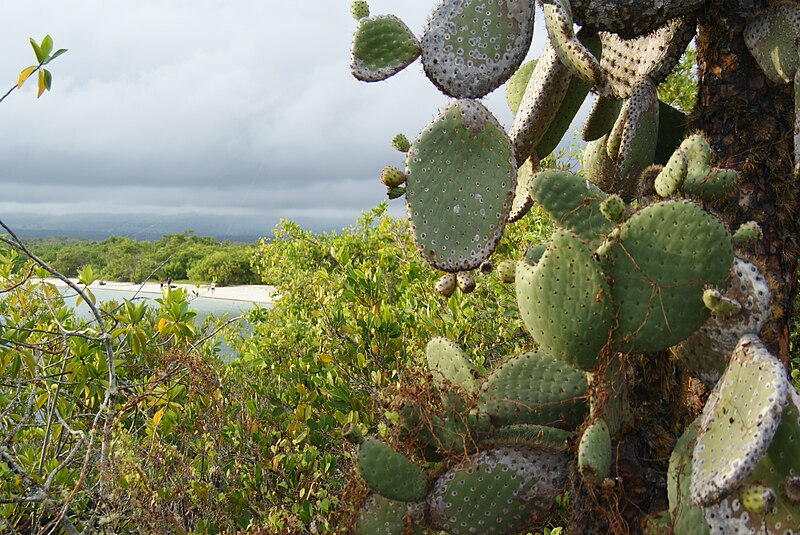File:Giant Galapogean Prickly Pear (Opuntia echios var. gigantea)... next to mangroves and a beach (7429203808).jpg

Original file (2,896 × 1,936 pixels, file size: 2.68 MB, MIME type: image/jpeg)
Captions
Captions
Summary[edit]
| DescriptionGiant Galapogean Prickly Pear (Opuntia echios var. gigantea)... next to mangroves and a beach (7429203808).jpg |
On Santa Cruz, Galapagos Islands, Ecuador For a discussion on why Opuntia of the Galapagos are so neat, and their relationship with the endemic giant tortoises, see this image: <a href="https://www.flickr.com/photos/31867959@N04/6012346984/in/set-72157628721441167/">www.flickr.com/photos/31867959@N04/6012346984/in/set-7215...</a> For a discussion on why I find Opuntia so neat morphologically, developmentally, and functionally: see this image: <a href="https://www.flickr.com/photos/31867959@N04/7457728654/in/set-72157628721441167/">www.flickr.com/photos/31867959@N04/7457728654/in/set-7215...</a>
Helsen, P., P. Verdyck, A. Tye, S. Van Dongen. 2009. Low levels of genetic differentiation between Opuntia echios varieties on Santa Cruz (Galapagos). Plant Systematics and Evolution 279:1–10. Helsen, P., R. A. Browne, D. A. Anderson, P. Verdyck, S. Van Dongen. 2009. Galápagos' Opuntia (prickly pear) cacti: extensive morphological diversity, low genetic variability. Biological Journal of the Linnean Society 96(2): 451–461. |
| Date | |
| Source | Giant Galapogean Prickly Pear (Opuntia echios var. gigantea)... next to mangroves and a beach |
| Author | Dallas Krentzel |
| Camera location | 0° 45′ 46.53″ S, 90° 20′ 19.79″ W | View this and other nearby images on: OpenStreetMap |
|---|
Licensing[edit]
- You are free:
- to share – to copy, distribute and transmit the work
- to remix – to adapt the work
- Under the following conditions:
- attribution – You must give appropriate credit, provide a link to the license, and indicate if changes were made. You may do so in any reasonable manner, but not in any way that suggests the licensor endorses you or your use.
| This image was originally posted to Flickr by Dallas Krentzel at https://flickr.com/photos/31867959@N04/7429203808. It was reviewed on 13 May 2021 by FlickreviewR 2 and was confirmed to be licensed under the terms of the cc-by-2.0. |
13 May 2021
File history
Click on a date/time to view the file as it appeared at that time.
| Date/Time | Thumbnail | Dimensions | User | Comment | |
|---|---|---|---|---|---|
| current | 18:12, 13 May 2021 |  | 2,896 × 1,936 (2.68 MB) | Sentinel user (talk | contribs) | Transferred from Flickr via #flickr2commons |
You cannot overwrite this file.
File usage on Commons
There are no pages that use this file.
Metadata
This file contains additional information such as Exif metadata which may have been added by the digital camera, scanner, or software program used to create or digitize it. If the file has been modified from its original state, some details such as the timestamp may not fully reflect those of the original file. The timestamp is only as accurate as the clock in the camera, and it may be completely wrong.
| Image title | SONY DSC |
|---|---|
| Camera manufacturer | SONY |
| Camera model | DSLR-A300 |
| Exposure time | 1/125 sec (0.008) |
| F-number | f/4.5 |
| ISO speed rating | 100 |
| Date and time of data generation | 18:16, 2 June 2011 |
| Lens focal length | 35 mm |
| Orientation | Normal |
| Horizontal resolution | 72 dpi |
| Vertical resolution | 72 dpi |
| Software used | DSLR-A300 v1.00 |
| File change date and time | 18:16, 2 June 2011 |
| Y and C positioning | Co-sited |
| Exposure Program | Normal program |
| Exif version | 2.21 |
| Date and time of digitizing | 18:16, 2 June 2011 |
| Meaning of each component |
|
| Image compression mode | 8 |
| APEX brightness | 6.37 |
| APEX exposure bias | 0 |
| Maximum land aperture | 3.61 APEX (f/3.49) |
| Metering mode | Pattern |
| Light source | Unknown |
| Flash | Flash did not fire, compulsory flash suppression |
| Supported Flashpix version | 1 |
| Color space | sRGB |
| File source | Digital still camera |
| Scene type | A directly photographed image |
| Custom image processing | Normal process |
| Exposure mode | Auto exposure |
| White balance | Auto white balance |
| Focal length in 35 mm film | 52 mm |
| Scene capture type | Standard |
| Contrast | Normal |
| Saturation | Normal |
| Sharpness | Normal |